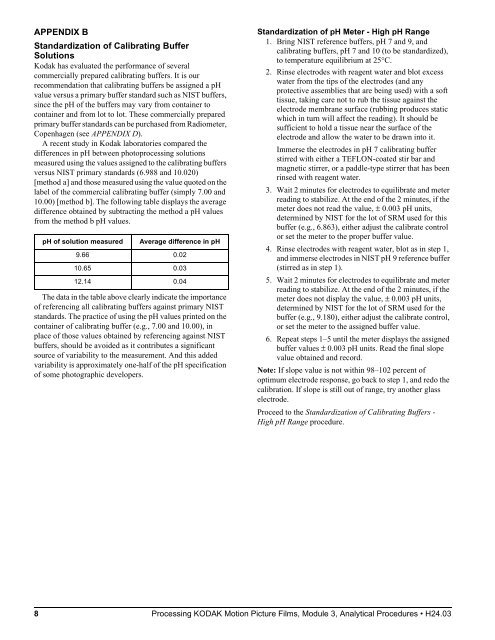Processing kodak motion picture films, module 3 analytical procedures
Processing kodak motion picture films, module 3 analytical procedures
Processing kodak motion picture films, module 3 analytical procedures
Create successful ePaper yourself
Turn your PDF publications into a flip-book with our unique Google optimized e-Paper software.
APPENDIX B<br />
Standardization of Calibrating Buffer<br />
Solutions<br />
Kodak has evaluated the performance of several<br />
commercially prepared calibrating buffers. It is our<br />
recommendation that calibrating buffers be assigned a pH<br />
value versus a primary buffer standard such as NIST buffers,<br />
since the pH of the buffers may vary from container to<br />
container and from lot to lot. These commercially prepared<br />
primary buffer standards can be purchased from Radiometer,<br />
Copenhagen (see APPENDIX D).<br />
A recent study in Kodak laboratories compared the<br />
differences in pH between photoprocessing solutions<br />
measured using the values assigned to the calibrating buffers<br />
versus NIST primary standards (6.988 and 10.020)<br />
[method a] and those measured using the value quoted on the<br />
label of the commercial calibrating buffer (simply 7.00 and<br />
10.00) [method b]. The following table displays the average<br />
difference obtained by subtracting the method a pH values<br />
from the method b pH values.<br />
pH of solution measured Average difference in pH<br />
9.66 0.02<br />
10.65 0.03<br />
12.14 0.04<br />
The data in the table above clearly indicate the importance<br />
of referencing all calibrating buffers against primary NIST<br />
standards. The practice of using the pH values printed on the<br />
container of calibrating buffer (e.g., 7.00 and 10.00), in<br />
place of those values obtained by referencing against NIST<br />
buffers, should be avoided as it contributes a significant<br />
source of variability to the measurement. And this added<br />
variability is approximately one-half of the pH specification<br />
of some photographic developers.<br />
Standardization of pH Meter - High pH Range<br />
1. Bring NIST reference buffers, pH 7 and 9, and<br />
calibrating buffers, pH 7 and 10 (to be standardized),<br />
to temperature equilibrium at 25°C.<br />
2. Rinse electrodes with reagent water and blot excess<br />
water from the tips of the electrodes (and any<br />
protective assemblies that are being used) with a soft<br />
tissue, taking care not to rub the tissue against the<br />
electrode membrane surface (rubbing produces static<br />
which in turn will affect the reading). It should be<br />
sufficient to hold a tissue near the surface of the<br />
electrode and allow the water to be drawn into it.<br />
Immerse the electrodes in pH 7 calibrating buffer<br />
stirred with either a TEFLON-coated stir bar and<br />
magnetic stirrer, or a paddle-type stirrer that has been<br />
rinsed with reagent water.<br />
3. Wait 2 minutes for electrodes to equilibrate and meter<br />
reading to stabilize. At the end of the 2 minutes, if the<br />
meter does not read the value, ± 0.003 pH units,<br />
determined by NIST for the lot of SRM used for this<br />
buffer (e.g., 6.863), either adjust the calibrate control<br />
or set the meter to the proper buffer value.<br />
4. Rinse electrodes with reagent water, blot as in step 1,<br />
and immerse electrodes in NIST pH 9 reference buffer<br />
(stirred as in step 1).<br />
5. Wait 2 minutes for electrodes to equilibrate and meter<br />
reading to stabilize. At the end of the 2 minutes, if the<br />
meter does not display the value, ± 0.003 pH units,<br />
determined by NIST for the lot of SRM used for the<br />
buffer (e.g., 9.180), either adjust the calibrate control,<br />
or set the meter to the assigned buffer value.<br />
6. Repeat steps 1–5 until the meter displays the assigned<br />
buffer values ± 0.003 pH units. Read the final slope<br />
value obtained and record.<br />
Note: If slope value is not within 98–102 percent of<br />
optimum electrode response, go back to step 1, and redo the<br />
calibration. If slope is still out of range, try another glass<br />
electrode.<br />
Proceed to the Standardization of Calibrating Buffers -<br />
High pH Range procedure.<br />
8 <strong>Processing</strong> KODAK Motion Picture Films, Module 3, Analytical Procedures H24.03
















